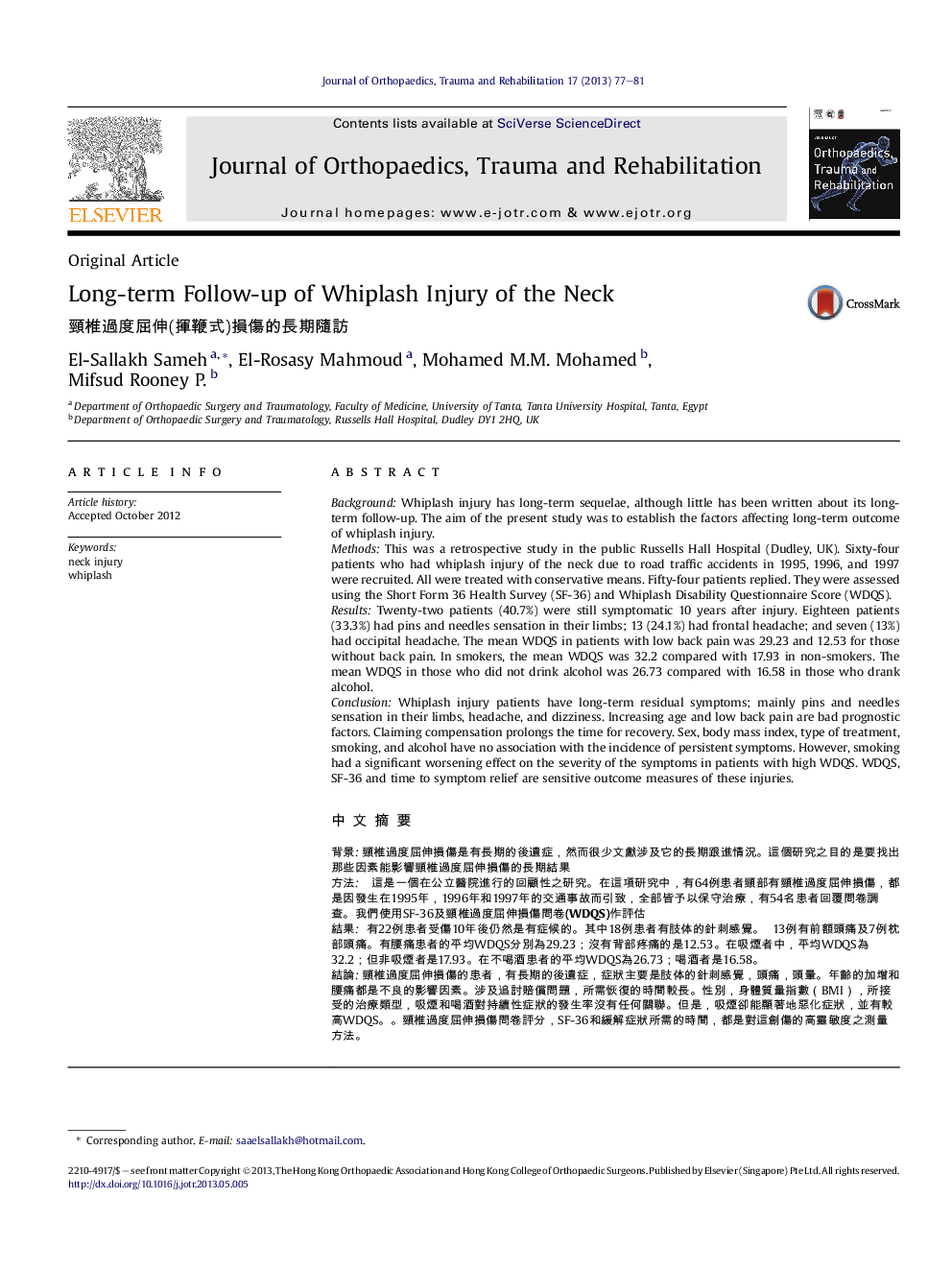| Article ID | Journal | Published Year | Pages | File Type |
|---|---|---|---|---|
| 4072639 | Journal of Orthopaedics, Trauma and Rehabilitation | 2013 | 5 Pages |
BackgroundWhiplash injury has long-term sequelae, although little has been written about its long-term follow-up. The aim of the present study was to establish the factors affecting long-term outcome of whiplash injury.MethodsThis was a retrospective study in the public Russells Hall Hospital (Dudley, UK). Sixty-four patients who had whiplash injury of the neck due to road traffic accidents in 1995, 1996, and 1997 were recruited. All were treated with conservative means. Fifty-four patients replied. They were assessed using the Short Form 36 Health Survey (SF-36) and Whiplash Disability Questionnaire Score (WDQS).ResultsTwenty-two patients (40.7%) were still symptomatic 10 years after injury. Eighteen patients (33.3%) had pins and needles sensation in their limbs; 13 (24.1%) had frontal headache; and seven (13%) had occipital headache. The mean WDQS in patients with low back pain was 29.23 and 12.53 for those without back pain. In smokers, the mean WDQS was 32.2 compared with 17.93 in non-smokers. The mean WDQS in those who did not drink alcohol was 26.73 compared with 16.58 in those who drank alcohol.ConclusionWhiplash injury patients have long-term residual symptoms; mainly pins and needles sensation in their limbs, headache, and dizziness. Increasing age and low back pain are bad prognostic factors. Claiming compensation prolongs the time for recovery. Sex, body mass index, type of treatment, smoking, and alcohol have no association with the incidence of persistent symptoms. However, smoking had a significant worsening effect on the severity of the symptoms in patients with high WDQS. WDQS, SF-36 and time to symptom relief are sensitive outcome measures of these injuries.
中文摘要背景頸椎過度屈伸損傷是有長期的後遺症,然而很少文獻涉及它的長期跟進情況。這個研究之目的是要找出那些因素能影響頸椎過度屈伸損傷的長期結果方法這是一個在公立醫院進行的回顧性之研究。在這項研究中,有64例患者頸部有頸椎過度屈伸損傷,都是因發生在1995年,1996年和1997年的交通事故而引致,全部皆予以保守治療,有54名患者回覆問卷調查。我們使用SF-36及頸椎過度屈伸損傷問卷(WDQS)作評估結果有22例患者受傷10年後仍然是有症候的。其中18例患者有肢体的針刺感覺。 13例有前額頭痛及7例枕部頭痛。有腰痛患者的平均WDQS分別為29.23;沒有背部疼痛的是12.53。在吸煙者中,平均WDQS為32.2;但非吸煙者是17.93。在不喝酒患者的平均WDQS為26.73;喝酒者是16.58。結論頸椎過度屈伸損傷的患者,有長期的後遺症,症狀主要是肢体的針刺感覺,頭痛,頭暈。年齡的加增和腰痛都是不良的影響因素。涉及追討賠償問題,所需恢復的時間較長。性別,身體質量指數(BMI),所接受的治療類型,吸煙和喝酒對持續性症狀的發生率沒有任何關聯。但是,吸煙卻能顯著地惡化症狀,並有較高WDQS。。頸椎過度屈伸損傷問卷評分,SF-36和緩解症狀所需的時間,都是對這創傷的高靈敏度之測量方法。
